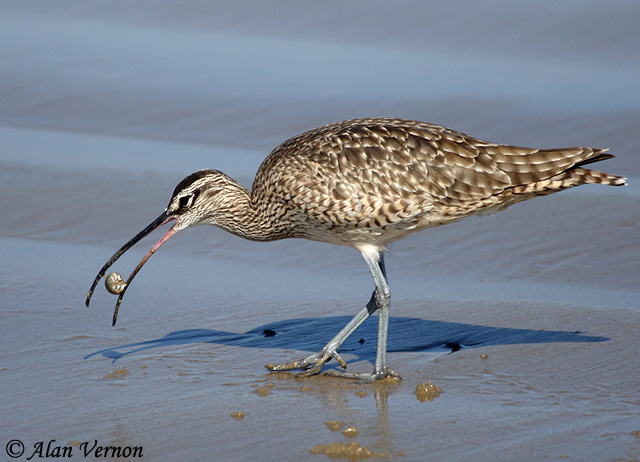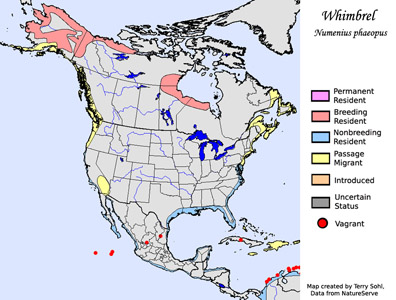 The Whimbrel is a very
widespread shorebird, breeding throughout the Arctic, and wintering along the
coasts of every continent except Antarctica. The American subspecies was
once considered its own species, formerly called the Hudsonian Curlew, but all
four distinct subspecies in the world were then reclassified under one species.
There are some distinct plumage differences between North American birds and
their Eurasian counterparts, however. Whimbrels commonly migrate along
coastlines, but are relatively scarce in the interior of the continent, although
they often can be found in traditional stopover points such as the Salton Sea
and the Great Lakes. They are quite uncommon migrants in South Dakota.
The Whimbrel is a very
widespread shorebird, breeding throughout the Arctic, and wintering along the
coasts of every continent except Antarctica. The American subspecies was
once considered its own species, formerly called the Hudsonian Curlew, but all
four distinct subspecies in the world were then reclassified under one species.
There are some distinct plumage differences between North American birds and
their Eurasian counterparts, however. Whimbrels commonly migrate along
coastlines, but are relatively scarce in the interior of the continent, although
they often can be found in traditional stopover points such as the Salton Sea
and the Great Lakes. They are quite uncommon migrants in South Dakota.
Habitat: Breeds on Arctic Tundra. In
migration, can be found in a wide variety of habitats, including mudflats, sandy
beaches, rocky coastlines, salt marshes, and flooded agricultural fields.
Diet: Summer diet consists of both insects
and berries. Along coastlines, eats mollusks, crustaceans, amphipods, and
marine worms.
Behavior: Walks along shorelines or mudflats,
probing in the mud with its beak or picking food items off the surface.
Breeding: Non-breeder in South Dakota. On their
breeding range, the nest is a shallow depression on the ground, lined with
mosses, lichen, and grasses. The female lays 3 or 4 eggs, and both parents
help to incubate them. When the eggs hatch, the young leave the nest and
feed themselves, but the parents tend to the young and vigorously protect them
from predators.
Song: Fast whistled 5-7 note
series...wi-wi-wi-wi-wi-wi.
Migration: Summers in Alaska and northern Canada. Winters
along the U.S. Pacific coast and Gulf Coast southward through South America.
Status: 19th century hunting took a heavy toll on
the Whimbrel.
Numbers haven't ever recovered to historical levels, but have recovered somewhat
in recent decades.
The IUCN lists the
Whimbrel as a species of "Least Concern".
2)
BirdWeb - Whimbrel
3)
Audubon Guide - Whimbrel
 The Whimbrel is a very
widespread shorebird, breeding throughout the Arctic, and wintering along the
coasts of every continent except Antarctica. The American subspecies was
once considered its own species, formerly called the Hudsonian Curlew, but all
four distinct subspecies in the world were then reclassified under one species.
There are some distinct plumage differences between North American birds and
their Eurasian counterparts, however. Whimbrels commonly migrate along
coastlines, but are relatively scarce in the interior of the continent, although
they often can be found in traditional stopover points such as the Salton Sea
and the Great Lakes. They are quite uncommon migrants in South Dakota.
The Whimbrel is a very
widespread shorebird, breeding throughout the Arctic, and wintering along the
coasts of every continent except Antarctica. The American subspecies was
once considered its own species, formerly called the Hudsonian Curlew, but all
four distinct subspecies in the world were then reclassified under one species.
There are some distinct plumage differences between North American birds and
their Eurasian counterparts, however. Whimbrels commonly migrate along
coastlines, but are relatively scarce in the interior of the continent, although
they often can be found in traditional stopover points such as the Salton Sea
and the Great Lakes. They are quite uncommon migrants in South Dakota.
